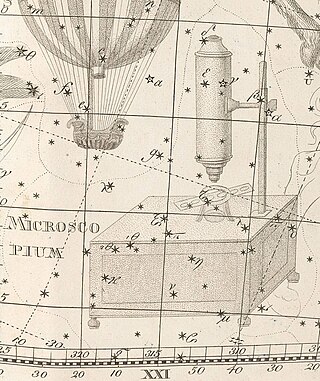| Observation data Epoch J2000 Equinox J2000 | |
|---|---|
| Constellation | Microscopium |
| Right ascension | 21h 17m 15.269s[3] |
| Declination | −38° 52′ 02.51″[3] |
| Apparent magnitude (V) | 6.67[4] |
| Characteristics | |
| Spectral type | M0Ve[5][6] |
| U−B color index | +1.165[5] |
| B−V color index | +1.395[5] |
| Variable type | Flare star |
| Astrometry | |
| Radial velocity (Rv) | +20.7[6] km/s |
| Proper motion (μ) | RA: −3,258.553 mas/yr[3] Dec.: −1,145.396 mas/yr[3] |
| Parallax (π) | 251.9124 ± 0.0352 mas[7] |
| Distance | 12.947 ± 0.002 ly (3.9696 ± 0.0006 pc) |
| Absolute magnitude (MV) | 8.69[4] |
| Details | |
| Mass | 0.60[4] M☉ |
| Radius | 0.51[8] R☉ |
| Luminosity (bolometric) | 0.072[9] L☉ |
| Luminosity (visual, LV) | 0.029 L☉ |
| Surface gravity (log g) | 4.78[8] cgs |
| Temperature | 3,800[10] K |
| Metallicity [Fe/H] | −0.01±0.04[11] dex |
| Rotation | 40±12 d[12] |
| Rotational velocity (v sin i) | 3.3[6] km/s |
| Age | 4.8±2.9[13] Gyr |
| Other designations | |
| Database references | |
| SIMBAD | data |
| Exoplanet Archive | data |
| ARICNS | data |
Location of Lacaille 8760 in the constellation Microscopium | |
Lacaille 8760 (AX Microscopii) is a red dwarf star in the constellation Microscopium. It is one of the nearest stars to the Sun at about 12.9 light-years' distance, and the brightest M-class main-sequence star in Earth's night sky, although it is generally too faint to be seen without a telescope. At an apparent magnitude of +6.7, it may only be visible to the unaided eye under exceptionally good viewing conditions, under dark skies.
This star was originally listed in a 1763 catalog that was published posthumously by the French Abbé Nicolas-Louis de Lacaille. He observed it in the southern sky while working from an observatory at the Cape of Good Hope.[14] Number 8760 was assigned to this star in the 1847 edition of Lacaille's catalogue of 9,766 stars by Francis Baily.[15]
In the past, Lacaille 8760 has been classified anywhere from spectral class K7 down to M2. In 1979, the Irish astronomer Patrick Byrne discovered that it is a flare star,[16] and it was given the variable star designation AX Microscopii, or AX Mic. As a flare star it is relatively quiescent.

Lacaille 8760 is one of the largest and brightest red dwarfs known, with about 60%[4] the mass and 51%[8] the radius of the Sun. It is about five[13] billion years old and is spinning at a projected rotational velocity of 3.3 km/s,[6] giving it a rotation period of roughly 40 days.[12] The star is radiating 7.2%[9] of the luminosity of the Sun from its photosphere at an effective temperature of 3,800 K.[10]
Despite efforts by astronomers, as of 2011 no planets had been detected in orbit around this star.[17]
Lacaille 8760 orbits around the galaxy with a relatively high ellipticity of 0.23.[18] Its closest approach to the Sun occurred about 20,000 years ago when it came within 12 light-years (3.7 parsecs).[19] Due to its low mass (60% of the Sun), it has an expected lifespan of about 75 billion (7.5 × 1010) years,[20] seven times longer than the Sun's.
- ^ e-rara.ch. Johann Elert Bode. Uranographia star atlas (1801), Tabula XVI
- ^ Johann Elert Bode. Allgemeine Beschreibung und Nachweisung der Gestirne (1801), Page 67
- ^ a b c Cite error: The named reference
GaiaDR2was invoked but never defined (see the help page). - ^ a b c d Cite error: The named reference
RECONSwas invoked but never defined (see the help page). - ^ a b c d Cite error: The named reference
SIMBADwas invoked but never defined (see the help page). - ^ a b c d Cite error: The named reference
aaa460_3_695was invoked but never defined (see the help page). - ^ Brown, A. G. A.; et al. (Gaia collaboration) (2021). "Gaia Early Data Release 3: Summary of the contents and survey properties". Astronomy & Astrophysics. 649: A1. arXiv:2012.01533. Bibcode:2021A&A...649A...1G. doi:10.1051/0004-6361/202039657. S2CID 227254300. (Erratum: doi:10.1051/0004-6361/202039657e). Gaia EDR3 record for this source at VizieR.
- ^ a b c Cite error: The named reference
apjss168_2_297was invoked but never defined (see the help page). - ^ a b Cite error: The named reference
apj801_2_143was invoked but never defined (see the help page). - ^ a b Cite error: The named reference
apj667_1_527was invoked but never defined (see the help page). - ^ Cite error: The named reference
Lindgren2017was invoked but never defined (see the help page). - ^ a b Cite error: The named reference
aaa208_1_159was invoked but never defined (see the help page). - ^ a b Cite error: The named reference
Boehle_et_al_2019was invoked but never defined (see the help page). - ^ Cite error: The named reference
st200307was invoked but never defined (see the help page). - ^ Francis Baily. A Catalogue of 9766 Stars (1847), Page 219
- ^ a b Cite error: The named reference
mnras195_143was invoked but never defined (see the help page). - ^ Cite error: The named reference
Carson2011was invoked but never defined (see the help page). - ^ Cite error: The named reference
rmaa34_37was invoked but never defined (see the help page). - ^ Cite error: The named reference
aaa379_634was invoked but never defined (see the help page). - ^ Cite error: The named reference
apj1_251_639was invoked but never defined (see the help page).

